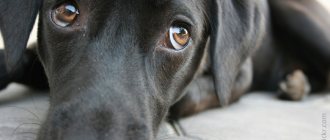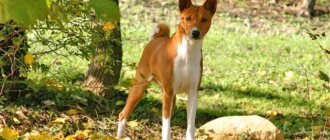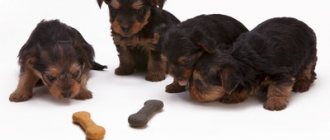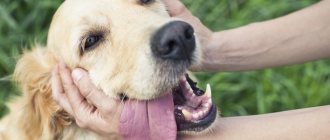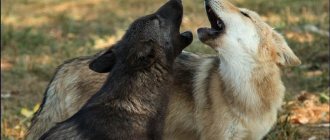When you think about your dog arching his back as a cause for concern, the problem shouldn't be a leisurely stretch repeated several times during a normal day. A pathologically arched back, which can also be thought of as a tucked belly, is a semi-permanent posture that a dog adopts in an attempt to relieve some kind of pain. Along with an arched, hunchbacked back and a tightly tucked belly, your dog's hindquarters will be downturned and the head and tail will hang down.
- Nausea
- Gastric volvulus (bloating)
- Anal sac diseases
- Intervertebral disc disease
- Spinal injury
Although these conditions occur in different parts of the body, they all have the same result: some kind of pain in the dog's midsection, causing him to arch his back in an attempt to relieve the pain. While nausea is often temporary and may go away with rest and a good drink of fresh water, it can also indicate a more serious underlying condition that requires veterinary evaluation and possible treatment. Each of the other conditions is potentially life-threatening, depending on the extent of development, and requires immediate veterinary evaluation and treatment.
Causes
The dog arches its back because it is in pain and tries to relieve the pain. Pain can occur in various parts of the dog's body, including the intestines, anal area, and spine.
- Nausea . Nausea is much less complicated and dangerous than gastric volvulus, also known as bloating. A dog may feel nauseous from something as simple as motion sickness, eating something that disturbs its intestines, or eating something toxic to its body, or the cause may be as complex and serious as gastroenteritis or parvovirus. Dogs of any breed, age, or gender can develop nausea.
- Dilatation of the stomach - volvulus . On the other hand, gastric volvulus is a condition in which the stomach rotates out of its normal position. It is mainly seen in large breed dogs with deep chests and is more common in older dogs than young ones. In each case, the dog's stomach hurts, so the dog may arch its back and pull up its stomach to relieve the pain.
- Diseases of the anal sac . Anal sac disorders can manifest as anal sac blockage, infection, or abscess. Your dog should be able to secrete fluid from the anal glands. If the fluid cannot be released, the affected fluid inside the anal glands creates increasing tension, causing the dog to bend its hindquarters down to relieve the tension. When a dog's hind end is tilted downward, its back may arch. Anal sac disease can develop in any dog, but is more common in small dogs.
- Intervertebral disc diseases . Intervertebral disc disease and other spinal injuries can cause your dog to experience potentially unbearable spinal pain. As with digestive and anal sac disorders, the dog will arch its back to try to relieve tension and pain caused by the disorder or injury. Intervertebral disc disease (IVD) occurs when the discs between a dog's vertebrae rupture. This can be very painful and even lead to loss of sensation and paralysis.
- Spinal injury . Spinal trauma can also be caused by external causes such as bites, car accidents and other injuries. While any dog can be injured by an external source, intervertebral disc disease is more likely in breeds that carry genetic dwarfism, such as Dachshunds, Pekingese, Beagles and Lhasa Apsas.
© shutterstock
Arthrosis
Arthrosis is a severe systemic disease that occurs as a result of hypokinesia, malnutrition, disorders of general metabolism and intraosseous metabolism, accompanied by changes in the synovial environment, bone structure and joint function. Arthrosis most often occurs in dogs in the hip, knee, tarsal and elbow joints, in dogs kept indoors with low mobility and inadequate feeding.
Etiology and pathogenesis. The disease is polyetiological. The disease is based on exogenous and endogenous causes that cause metabolic disorders, trophic regulation, intraosseous metabolism and are accompanied by changes in the synovial environment, bone structure and function of the affected organ. In dogs, especially indoor dogs, active movements are limited. As a result of chronic lack of movement, the formation of synovial fluid in joints, especially complex and lightly loaded ones, gradually decreases. Trophic changes in joint tissues contribute to the development of dystrophic and atrophic processes. The synovial environment and function of the affected joint are impaired. Insufficient content of manganese, copper, zinc, cobalt salts in the diet, physical inactivity are accompanied by a decrease in the content of sialic acids, the absorption and deposition of calcium and phosphorus, a disorder of intraosseous metabolism and morphological changes in the articulating bones of the joints. As a result of a lack of osteotropic microelements in the diet and blood serum, the energy cycle of osteoblasts is inhibited, protein synthesis and bone formation are delayed, cell death begins, the formation of bone structures is disrupted, and dystrophic and atrophic processes develop in the articular bones.
Clinic. A change in the structure of bone tissue in a sick dog is accompanied by a progressive limitation of the function of the hip and knee joints; when moving, a crunching sound appears in the affected joint, and the dog develops lameness. Restriction of movement in the affected joint is accompanied by spontaneous partial immobility of the affected joint. A significant group of muscles in the affected limb atrophies.
Veterinary specialists confirm the diagnosis of arthritis with the results of an X-ray examination - the joint space is narrowed, osteoporosis of the bones and general osteodystrophy are noted.
Treatment. Treatment for arthritis is similar to treatment for hip dysplasia.
What to do if your dog arches his back
The correct therapeutic response to your dog's back arch will depend on the cause. You should closely monitor your dog for symptoms of nausea and withhold food and water to see if the symptoms go away. Symptoms may subside within 2-3 hours, but if not, your dog should be examined by a veterinarian. Your veterinarian may perform a blood test to determine the exact cause. Parasites can often be cured with a short course of oral medications. Dogs suffering from parvo will require immediate intravenous fluids followed by a special diet of highly digestible foods; if they survive the first 3-4 days, the prognosis for recovery is good. Surgery may be required to relieve intestinal obstruction.
Unlike nausea, there are no mild cases of gastric volvulus; it's always serious. Your dog's condition will initially be stabilized by administering oxygen and IV fluids, then the stomach will be decompressed by releasing fluid and air through a tube, catheter, or needle. Surgery will then be performed, followed by limited exercise, diet and long-term follow-up.
Anal sac diseases require that accumulated fluid be released from your dog's anal sacs. Your veterinarian may express the anal glands, flush out infected glands, or lance abscesses followed by a course of antibiotics to prevent infection.
Spinal diseases will be treated depending on the severity of the situation. Mild cases of intervertebral disc disease can sometimes be treated with anti-inflammatory or corticosteroid medications, but more severe cases require surgery.
Possible complications
If you do not seek veterinary help in time (or do not diagnose the disease correctly), the inflammation will continue to develop and begin to affect nearby areas of the body. In this case, it will be almost impossible to stop the inflammatory process without consequences. Complications that are possible with myositis in dogs include:
- weakening of one or several muscles at once, up to complete death (in which case they cease to perform their functions);
- further spread of the infectious disease and the occurrence of abscesses (purulent lesions);
- change in size of one or more damaged muscles - they become deformed and become noticeably shorter;
- Deterioration of vision in an animal is one of the common consequences of eosinophilic myositis.
Preventing back arching
Nausea prevention is a practice you should incorporate into your daily care for your healthy dog. Keep toxic substances away from it. Pay close attention to his surroundings, including making sure there is nothing dangerous in the yard. If any potentially dangerous elements, such as bees and wasps, cannot be removed from the yard, then you should always supervise your dog when he is in the yard. Make sure his toys are safe and unbreakable, without any easily swallowed parts. Because other dogs can carry dangerous viruses such as parvo, always monitor your dog's use of parks. Because gastric volvulus or bloating is often associated with age or genetics, it can't always be prevented, but you can reduce the likelihood of it developing by keeping your dog calm and stress-free.
You may be able to learn how to express your dog's anal glands at home; Discuss this with your veterinarian. Check your dog's anal sacs regularly to make sure they are not exposed to excess retained fluid. And while some forms of spinal injuries have a genetic basis, such as intervertebral disc disease, generally keeping your dog injury-free can help prevent injuries from car accidents, gunshot wounds and bites.
Prevention
Prevention of the spread of discopathy among purebred dogs is carried out through culling and preventing diseased individuals from breeding.
Due to the fact that mating begins in animals that have reached the age of 1.5-2 years, the disease is established later than the appearance of the first litters. Taking into account heredity, it can be recommended not to allow puppies from parents who have symptoms of discopathy into breeding. Losing excess weight and combating a sedentary lifestyle is the second most important disease prevention. Increased body weight creates a significant load on the structure of the vertebrae, forcing it to bend. Timely consultation with a doctor at a stage when the manifestations of the disease are still weakly expressed makes it possible to stop its development in 90% of cases.
Are there any breeds at risk?
Degenerative changes in joint tissues in puppies occur due to a discrepancy in the growth rates of different parts of the skeleton. The following breeds are affected by this disorder:
- Great Danes and Shepherds;
- English setters;
- Newfoundlands;
- Bernese Mountain Dogs;
- Rottweilers;
- Old English Sheepdogs (Bobtails);
- Saint Bernards;
- Labradors;
- Cane Corso;
- retrievers.
The risk group also includes mestizos obtained by crossing the listed representatives. The first signs of the disease in all these animals appear at the age of 4-10 months. Most often, cartilage tissue becomes thinner in the knee, elbow, shoulder or hock joints, which bear the greatest load.
Why do dogs' bodies tremble?
- From biology textbooks we know that trembling is considered an unconditioned reflex. The animal may shake from the manifestation of emotions: aggression, joy, excitement. After strong emotions, the body continues to tremble, experiencing the consequences.
- The dog may tremble if there is a surge of hormones in the body. This sometimes happens when seeing an animal of the opposite sex. In the latter case, the dog is characterized by violent behavior and does not follow the commands of its owners.
- The animal is capable of shaking from the cold. To calm the trembling, the owners must rub the pet and force it to move actively.
- When traveling long distances or moving to a new place, the animal’s adaptation occurs slowly. In unusual climatic conditions, the animal begins to tremble, body temperature rises or falls, and appetite decreases. The cause of the condition is fluctuations in air temperature and changes in humidity.
- The cause of trembling is fear. Adrenaline is released into the blood, the heartbeat accelerates, and the body begins to tremble. The animal refuses to eat. When driving in a car, the dog gets sick. The condition is accompanied by body tremors, vomiting, loss of appetite, and sometimes loss of consciousness. The animal may not walk for some time. The way out of this situation will be sedatives. The dog falls asleep, saving energy.
- Active life and excessive excitability are considered to be the cause of sleep disturbances. An animal may move its paws in its sleep, whine, or stand up abruptly in its sleep without waking up, which happens due to a lack of magnesium.
- Pets, including dogs, are sensitive to hypothermia and drafts. Quadrupeds have a much higher body temperature than humans. Dog owners should not rely on their own instincts. If the room is warm, you still need to protect your pets from drafts, especially after bathing. After washing, the animal's fur should be wiped with a terry towel. You need to wipe until the wool becomes almost dry. Use a hair dryer for drying.
Obesity
This is a real scourge of the breed. Created for hunting, for a life full of activity, the city dachshund often finds itself in a situation where its instincts remain unfulfilled. As a result, bulimia becomes second nature for the dog. In this place we could show shocking photos of animals in the final stages of obesity, but we will not do this: there is no desire to spread negativity.
There are not so many specific diseases in dachshunds, and all of them are treatable or can be easily prevented by proper feeding and maintenance.
With all our hearts we wish all dogs good health and love!
Care and diet, postoperative period
To recover, a sick pet requires special care and a radical change in diet. Physical activity must be dosed to avoid fatigue and muscle atrophy. Here it is important to build on the animal’s well-being and the veterinarian’s recommendations.
Swimming is one of the most useful and safe exercises. Your four-legged pet can be taken to the pool or regularly taken to a warm lake.
Fast walking and light jogging are also allowed. You will only have to give up activities that require strength, speed and agility. This includes exercises on apparatus in obedience and agility courses, as well as various jumps, including jumping onto a sofa or bed.
When breastfeeding, it is important to avoid weight gain, which can worsen the situation. Due to limited activity, achieving good physical shape can only be achieved by reviewing your diet. To do this you need:
- Reduce daily calorie intake.
- Reduce foods high in protein and calcium.
- Provide sufficient vitamins and minerals.
- Pay attention to healthy fats that reduce pain and improve endurance.
For convenience, veterinarians recommend switching to a medicinal line of dry food designed for animals with musculoskeletal diseases. Most of them are marked j/d.
The dog often tucks its tail and shakes in the street
The symptom indicates stress, fear or uncertainty. An animal can experience not only recent events, but also disturbing memories from the past. Pets are often frightened by natural events:
- when other dogs try to make friends with them;
- during lightning and thunder;
- if the owner shouts or scolds;
- when another animal attacks.
The first case is due to lack of socialization. The second factor does not depend on breed and upbringing, it is simply a character trait. The third and fourth are the norm - a tail between your legs is a psychosomatic reaction. The owner's job is to protect him from stress.
Small breeds have increased nervousness. If raised incorrectly, they become nervous when they lose personal contact with the owner. Therefore, when training, they are accustomed to the idea that a person leaves him for a while and this is the norm.
Genetic disorders
It’s paradoxical, but true - purebred dogs, in whose development a lot of money, time, and effort are invested, are considered less healthy than ordinary courtyard terriers “without family or tribe,” for whose reproduction and condition Mother Nature is solely responsible. But there is an absolutely logical explanation for this: the gene pool of outbred dogs is determined by natural selection, according to the principle “survival of the fittest.” The majority of representatives of the breed are prone to hereditary disorders, including problems with the structure of the skeleton.
A puppy tucking its tail because it physically cannot wear it any other way is clear evidence of a congenital pathology. This anomaly can be for three reasons:
- Careless breeding is the most common factor in producing puppies with bone problems that cause tail tucks.
- Genetic mutations.
- Specific features of the body.
A knuckle is the fusion of several vertebrae (two or more), causing deformation of the spinal column. When the spinal nerve endings are pinched during fusion, the tail loses flexibility, its muscles are constantly compressed or tense, and mobility is also partially lost. Sometimes such a disorder causes the animal to hunch over when walking and sit up poorly.
Diseases of internal organs
The dog may experience pain due to diseases of the internal organs in the pelvic area: prostatitis, disease of the uterus, bladder, rectum, para-anal glands or perineum. As a result, the animal also shifts its center of gravity forward, hunching its spine, lowering its head and shortening its steps, which forms a constrained gait.
It is not always possible to notice the listed symptoms; the intensity of pain varies. Such ailments can only be detected through examinations - X-rays, MRI, CT, ultrasound and others.
Behavioral factors
Deviations in behavior are inherent in any pet, but for oddities to appear there must be provoking reasons.
Conventionally, they can be combined into three general groups:
- Low socialization, mistakes in education.
- Consequences of extreme stress.
- Mental disorders (difficult to diagnose).
Animal signals about the state of its nervous system:
- Fear - the dog tries to leave, his ears are pressed to his skull.
- Panic fear - the dog tucks its tail and whines, begins to hide its head, and rush about randomly.
- Passive defense - there are signs of fear, but the animal intends to defend itself.
Fearfulness is not inherent in dogs at the genetic level. If an animal constantly shows fear and anxiety, it means that it is under constant stress. The stressful state turns into depression, and behavioral deviations become more pronounced: the ward shits indoors, stops obeying at home and on the go, spoils things, and may bite.


